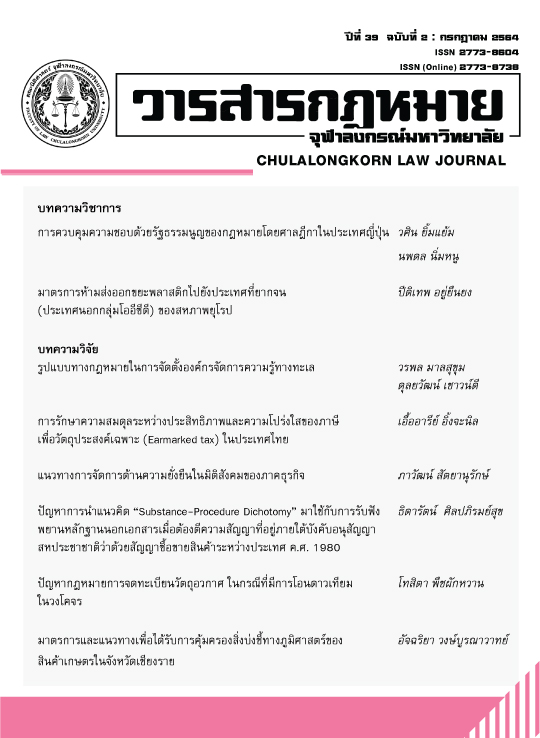มาตรการและแนวทางเพื่อได้รับการคุ้มครองสิ่งบ่งชี้ทางภูมิศาสตร์ ของสินค้าเกษตรในจังหวัดเชียงราย
Main Article Content
บทคัดย่อ
เชียงรายเป็นจังหวัดที่มีพัฒนาการที่ดีในการใช้สิ่งบ่งชี้ทางภูมิศาสตร์ (Geographical Indication: GI)
เพื่อเพิ่มมูลค่าทางเศรษฐกิจให้กับผลิตภัณฑ์ท้องถิ่นและขยายการเข้าถึงตลาดของผลิตภัณฑ์ทางการเกษตร
รวมถึงผลิตภัณฑ์เกษตรแปรรูปไปยังตลาดต่างประเทศ อย่างไรก็ตามพบว่าการใช้สิ่งบ่งชี้ทางภูมิศาสตร์เป็น
เครื่องมือในการส่งเสริมการพัฒนาท้องถิ่นในจังหวัดเชียงรายนั้นยังไม่ประสบความสำเร็จเท่าที่ควร ดังนั้นบทความ
วิจัยนี้จึงมีวัตถุประสงค์เพื่อศึกษาถึงมาตรการทางกฎหมายในการให้ความคุ้มครองสิ่งบ่งชี้ทางภูมิศาสตร์ รวมถึง
ปัญหาและอุปสรรคต่าง ๆ ที่เกี่ยวข้อง เพื่อที่จะเสนอแนะมาตรการและแนวทางที่เหมาะสมในการส่งเสริมการ
คุ้มครองและการใช้ประโยชน์จากสิ่งบ่งชี้ทางภูมิศาสตร์ของจังหวัดเชียงราย โดยจากการศึกษาพบว่าความท้าทายที่
สำคัญ ได้แก่ การขาดการรวมกลุ่มกันอย่างเข้มแข็งของชุมชน การขาดความรู้และความเข้าใจที่เพียงพอเกี่ยวกับ
สิ่งบ่งชี้ทาภูมิศาสตร์ ขาดระบบควบคุมตรวจสอบคุณภาพสินค้าสิ่งบ่งชี้ทางภูมิศาสตร์ที่ชัดเจนและได้มาตรฐาน
สากลในการตรวจสอบและรักษาคุณภาพให้สอดคล้องกับคุณสมบัติของสินค้าที่ได้รับการขึ้นทะเบียน ตลอดจน
การขาดงบประมาณและบุคลากรที่เหมาะสมและเพียงพอ
ดังนั้นในการส่งเสริมและผลักดันให้สินค้าเกษตรของจังหวัดเชียงได้รับการคุ้มครองสิ่งบ่งชี้ทางภูมิศาสตร์
ทั้งในประเทศไทยและในสหภาพยุโรปนั้น ผู้วิจัยมีข้อเสนอแนะในเชิงนโยบายดังต่อไปนี้ ประการแรก หน่วยงาน
ภาครัฐควรสนับสนุนการสร้างแกนนำชุมชนเพื่อเป็นแกนนำในการผลักดันสินค้าที่มีเอกลักษณ์ของชุมชนให้ได้รับ
การคุ้มครองสิ่งบ่งชี้ทางภูมิศาสตร์ ประการที่สอง หน่วยงานที่เกี่ยวข้องทั้งจากภาครัฐและภาคเอกชนควรสร้าง
ความรู้ความเข้าใจถึงความสำคัญ และประโยชน์ของการได้รับการคุ้มครองสิ่งบ่งชี้ทางภูมิศาสตร์ให้กับผู้ผลิตใน
ชุมชน บุคลากรจากหน่วยงานของรัฐ และผู้บริโภค ประการที่สาม พระราชบัญญัติคุ้มครองสิ่งบ่งชี้ทางภูมิศาสตร์
พ.ศ. 2546 ควรได้รับการแก้ไขเพื่อจัดให้มีระบบควบคุมตรวจสอบที่สอดคล้องกับมาตรฐานของสหภาพยุโรป
เพื่อรับรองคุณภาพสินค้าสิ่งบ่งชี้ทางภูมิศาสตร์ของประเทศไทย ประการสุดท้าย รัฐบาลควรจัดสรรงบประมาณ
และผู้เชี่ยวชาญด้านสิ่งบ่งชี้ทางภูมิศาสตร์ให้เพียงพอให้แก่หน่วยงานของรัฐที่เกี่ยวข้อง โดยเฉพาะอย่างยิ่งกรม
ทรัพย์สินทางปัญญาและสำนักงานพาณิชย์จังหวัดเพื่อเพิ่มประสิทธิภาพในการปฏิบัติงาน
Article Details
ลิขสิทธิ์และเนื้อหาในเว็บไซต์ของวารสารกฎหมาย (รวมถึง โดยไม่จำกัดเฉพาะ เนื้อหา รหัสคอมพิวเตอร์ งานศิลป์ ภาพถ่าย รูปภาพ ดนตรีกรรม โสตทัศนวัสดุ) เป็นกรรมสิทธิ์ของวารสารกฎหมาย และผู้ได้รับการโอนสิทธิทุกราย
1. วารสารกฎหมาย ให้อนุญาตให้คุณใช้สิทธิอันไม่เฉพาะเจาะจงที่สามารถถูกถอนเมื่อใดก็ได้ โดยไม่มีค่าใช้จ่าย ในการ
- เยี่ยมชมเว็บไซต์และเอกสารในเว็บไซต์นี้ จากคอมพิวเตอร์หรือเครื่องมือสื่อสารผ่านเว็บบราวเซอร์
- คัดลอกและจัดเก็บเว็บไซต์และเอกสารในเว็บไซต์นี้บนลงคอมพิวเตอร์ของคุณผ่านระบบความจำ cache
- สั่งพิมพ์เอกสารจากเว็บไซต์นี้สำหรับการใช้ส่วนตัวของคุณ
- ผลงานที่ได้รับการตีพิมพ์โดยวารสารกฎหมาย จุฬาลงกรณ์มหาวิทยาลัย ถูกคุ้มครองภายใต้ Creative Commons Attribution 4.0 International License ซึ่งอนุญาตให้ทุกคนสามารถคัดลอก แจกจ่าย ดัดแปลง ส่งต่อ ผลงานได้ ก็ต่อเมื่อผลงานและแหล่งข้อมูลได้รับการอ้างอิงอย่างเหมาะสม
2. วารสารกฎหมาย จุฬาลงกรณ์มหาวิทยาลัย สงวนสิทธิ์ไม่อนุญาตให้คุณใช้สิทธิอื่นใดที่เกี่ยวข้องกับเว็บไซต์และเอกสารบนเว็บไซต์นี้ เช่น การคัดลอก ดัดแปลง เปลี่ยนแปลง ส่งต่อ ตีพิมพ์ แจกจ่าย เผยแพร่ จัดแสดงในที่สาธารณะ ไม่ว่าจะในรูปแบบใดก็ตาม ซึ่งเว็บไซต์หรือเอกสารบนเว็บไซต์ โดยไม่อ้างอิงถึงแหล่งข้อมูลหรือโดยไม่ได้รับอนุญาตเป็นลายลักษณ์อักษรจากวารสารกฎหมาย จุฬาลงกรณ์มหาวิทยาลัย
3. คุณอาจขออนุญาตที่จะใช้เอกสารอันมีลิขสิทธิ์บนเว็บไซต์นี้โดยการเขียนอีเมลล์มายัง journal@law.chula.ac.th
4. วารสารกฎหมาย จุฬาลงกรณ์มหาวิทยาลัย เข้มงวดกับการคุ้มครองลิขสิทธิ์อย่างมาก หากวารสารกฎหมาย จุฬาลงกรณ์มหาวิทยาลัยพบว่าคุณได้ใช้เอกสารอันมีลิขสิทธิ์บนเว็บไซต์นี้โดยไม่ถูกต้องตามการอนุญาตให้ใช้สิทธิ ดังที่กล่าวไปข้างต้น วารสารกฎหมาย จุฬาลงกรณ์มหาวิทยาลัยอาจดำเนินคดีตามกฎหมายต่อคุณได้ เพื่อเรียกร้องค่าเสียหายที่เป็นตัวเงินและคำขอชั่วคราวให้คุณหยุดการใช้เอกสารดังกล่าว ทั้งนี้ คุณอาจถูกสั่งให้ชดใช้ค่าใช้จ่ายใดๆ ที่เกี่ยวข้องกับการดำเนินการตามกฎหมายนี้
หากคุณพบเห็นการใช้เอกสารอันมีลิขสิทธิ์ของวารสารกฎหมาย จุฬาลงกรณ์มหาวิทยาลัย ที่ขัดหรืออาจขัดต่อการอนุญาตให้ใช้สิทธิดังที่ได้กล่าวไปข้างต้น โดยเชื่อว่าได้ละเมิดลิขสิทธิ์ของคุณหรือของผู้อื่น สามารถร้องเรียนมาได้ที่ journal@law.chula.ac.th
เอกสารอ้างอิง
Bramley C et al. ‘The Economics of Geographical Indications: Towards A Conceptual Framework for Geographical Indication Research in Developing Countries’, in WIPO (ed), The Economic of Intellectual Property (WIPO, Geneva 2009).
Dagne TW, Intellectual Property and Traditional Knowledge in the Global Economy: Translating Geographical Indications for Development (Routledge 2015).
Downes DR, ‘How Intellectual Property Could Be a Tool to Protect Traditional Knowledge’ (2000) 25 Columbia Journal of Environmental Law 253.
European Commission, ‘Geographical Indications in the EU’ (28-19 March 2019, Lima) available at
European Commission, ‘New Search Database for Geographical Indications in the EU’ (2020)
European Commission, ‘Green Paper on the protection of geographical indications for non-agricultural products – Frequently Asked Questions, MEMO/14/486, Brussels/Strasbourg’ (2014)
European Commission, ‘Quality Schemes Explained’
European Commission, ‘Geographical Indications for non-agricultural products’
European Commission, ‘Quality Schemes Explained’
Favale, M. and Borghi, M., Harmonization of Intellectual Property Rights within and beyond the European Union: The Acquis Communautaire in the Framework of the European Neighbourhood Policy, (2013) WP5/25 Search Working Paper, SEARCH Project,
Gervais D, The TRIPS Agreement: Drafting History and Analysis (2nd edn, Sweet and Maxwell 2003).
Hemarachata C, Characteristics of Intellectual Property Law: The Basic Knowledge of Copyright, Patent, Trademark, Trade secrets, Semiconductor, New Plant Variety (9th edition, Nititham Publishing House 2016).
Hoang G et al., ‘The Impact of Geographical Indications on Sustainable Rural Development: A Case Study of the Vietnamese Cao Phong Orange’ (2020) MDPI.
International Organization for Standardization (ISO), ‘ISO/IEC 17065:2012(en) Conformity assessment — Requirements for bodies certifying products, processes and services’
Kuanpoth J and Srethasirote B, Geographical Indication, Intellectual Property, and Community rights (Nititham Publishing House 2013).
Malik M, ‘Updates on Geographical Indications in the ASEAN Region’ (2 July 2019, Lisbon, Portugal) available at
National News Bureau of Thailand, Department of Intellectual Property Continues to promote GI products to help increase local incomes and improve the economic foundation (2019)
Navarra C and Elodie Thirion, ‘Geographical Indications for Non-agricultural products: Cost of Non-Europe Report’ (European Parliament 2019).
O’Connor B, The Law of Geographical Indications (Cameron May 2004).
UNCTAD, ‘Why Geographical Indications for Least Developed Countries (LDCs)?’ (2015).
Preusse V, ‘Control Systems for Geographical Indications in the EU and Thailand: Do the EU’s Standard Travel Abroad?’ (MSc Thesis, Wageningen University and Research 2019).
Pomares A, ‘Controls of Geographical Indications (EU System)’ (EUIPO 2020) available at
Sautier D, ‘Seminar on Geographical Indications’ (20 September 2018, Hanoi, Vietnam)
Sciarra AF and Louise Gellman, ‘Geographical indications: why traceability systems matter and how they add to brand value’ (2012) 7 Journal of Intellectual Property Law & Practice 264.
Seville C, EU Intellectual Property Law and Policy (Edward Elgar Publishing 2009).
Sirisakbanjong T et al. Research on Legal Measures of Geographical Indication to Protect Traditional Knowledge in Food in the ASEAN Community: Lessons for Thailand, (The Secretariat of the House of Representatives 2015).
Sylvander B and Barham E, ‘Introduction’ in Elizabeth Barham and Bertil Sylvander (eds), Labels of Origin for Food: Local Development, Global Recognition (CABI 2011).
The Department of Intellectual Property, ‘GI Products in Region’ (2020),
WTO, Geographical Indications (2020)


